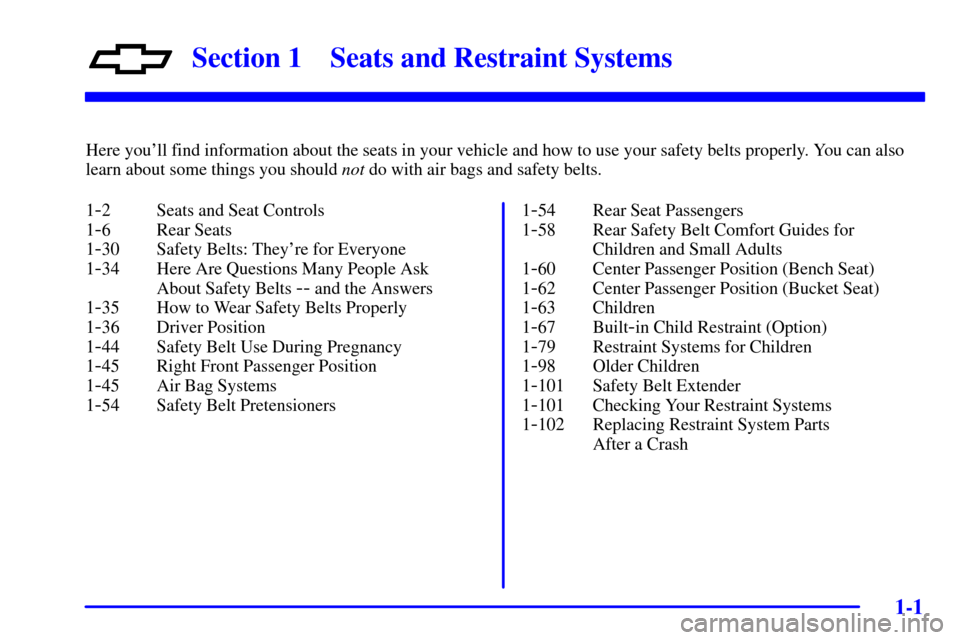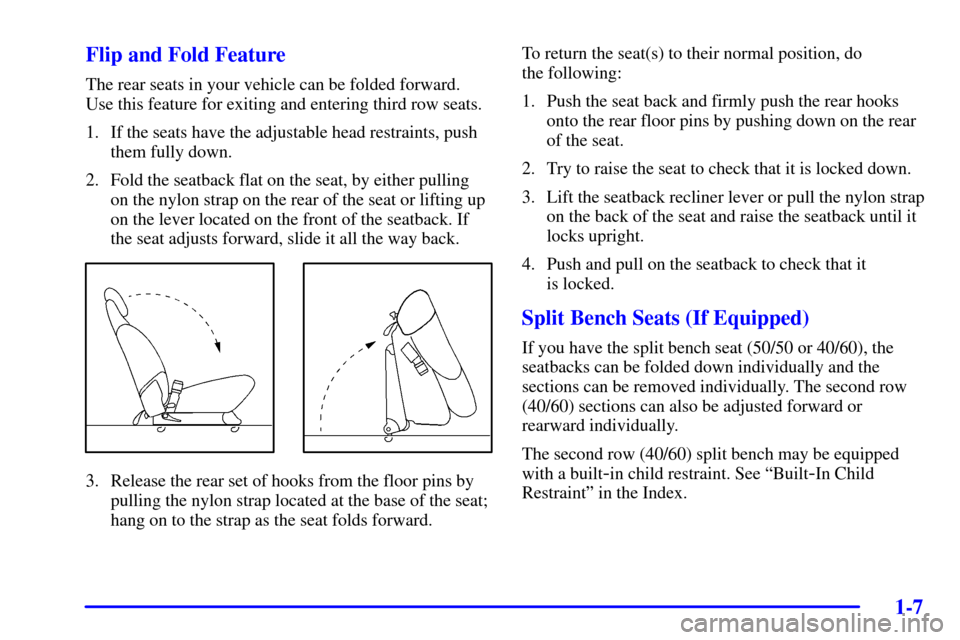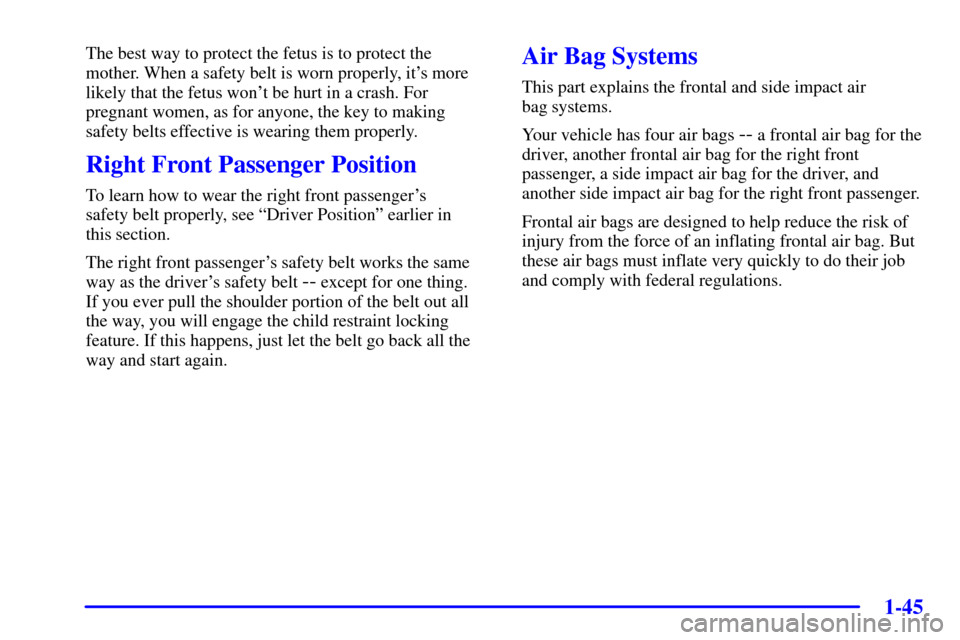Page 7 of 486

1-
1-1
Section 1 Seats and Restraint Systems
Here you'll find information about the seats in your vehicle and how to use your safety belts properly. You can also
learn about some things you should not do with air bags and safety belts.
1
-2 Seats and Seat Controls
1
-6 Rear Seats
1
-30 Safety Belts: They're for Everyone
1
-34 Here Are Questions Many People Ask
About Safety Belts
-- and the Answers
1
-35 How to Wear Safety Belts Properly
1
-36 Driver Position
1
-44 Safety Belt Use During Pregnancy
1
-45 Right Front Passenger Position
1
-45 Air Bag Systems
1
-54 Safety Belt Pretensioners1
-54 Rear Seat Passengers
1
-58 Rear Safety Belt Comfort Guides for
Children and Small Adults
1
-60 Center Passenger Position (Bench Seat)
1
-62 Center Passenger Position (Bucket Seat)
1
-63 Children
1
-67 Built-in Child Restraint (Option)
1
-79 Restraint Systems for Children
1
-98 Older Children
1
-101 Safety Belt Extender
1
-101 Checking Your Restraint Systems
1
-102 Replacing Restraint System Parts
After a Crash
Page 13 of 486

1-7
Flip and Fold Feature
The rear seats in your vehicle can be folded forward.
Use this feature for exiting and entering third row seats.
1. If the seats have the adjustable head restraints, push
them fully down.
2. Fold the seatback flat on the seat, by either pulling
on the nylon strap on the rear of the seat or lifting up
on the lever located on the front of the seatback. If
the seat adjusts forward, slide it all the way back.
3. Release the rear set of hooks from the floor pins by
pulling the nylon strap located at the base of the seat;
hang on to the strap as the seat folds forward.To return the seat(s) to their normal position, do
the following:
1. Push the seat back and firmly push the rear hooks
onto the rear floor pins by pushing down on the rear
of the seat.
2. Try to raise the seat to check that it is locked down.
3. Lift the seatback recliner lever or pull the nylon strap
on the back of the seat and raise the seatback until it
locks upright.
4. Push and pull on the seatback to check that it
is locked.
Split Bench Seats (If Equipped)
If you have the split bench seat (50/50 or 40/60), the
seatbacks can be folded down individually and the
sections can be removed individually. The second row
(40/60) sections can also be adjusted forward or
rearward individually.
The second row (40/60) split bench may be equipped
with a built
-in child restraint. See ªBuilt-In Child
Restraintº in the Index.
Page 41 of 486
1-35
Q:If I'm a good driver, and I never drive far from
home, why should I wear safety belts?
A:You may be an excellent driver, but if you're in an
accident
-- even one that isn't your fault -- you and
your passengers can be hurt. Being a good driver
doesn't protect you from things beyond your
control, such as bad drivers.
Most accidents occur within 25 miles (40 km)
of home. And the greatest number of serious
injuries and deaths occur at speeds of less
than 40 mph (65 km/h).
Safety belts are for everyone.
How to Wear Safety Belts Properly
Adults
This part is only for people of adult size.
Be aware that there are special things to know
about safety belts and children. And there are different
rules for smaller children and babies. If a child will
be riding in your vehicle, see the part of this manual
called ªChildren.º Follow those rules for
everyone's protection.
First, you'll want to know which restraint systems your
vehicle has.
We'll start with the driver position.
Page 51 of 486

1-45
The best way to protect the fetus is to protect the
mother. When a safety belt is worn properly, it's more
likely that the fetus won't be hurt in a crash. For
pregnant women, as for anyone, the key to making
safety belts effective is wearing them properly.
Right Front Passenger Position
To learn how to wear the right front passenger's
safety belt properly, see ªDriver Positionº earlier in
this section.
The right front passenger's safety belt works the same
way as the driver's safety belt
-- except for one thing.
If you ever pull the shoulder portion of the belt out all
the way, you will engage the child restraint locking
feature. If this happens, just let the belt go back all the
way and start again.
Air Bag Systems
This part explains the frontal and side impact air
bag systems.
Your vehicle has four air bags
-- a frontal air bag for the
driver, another frontal air bag for the right front
passenger, a side impact air bag for the driver, and
another side impact air bag for the right front passenger.
Frontal air bags are designed to help reduce the risk of
injury from the force of an inflating frontal air bag. But
these air bags must inflate very quickly to do their job
and comply with federal regulations.
Page 53 of 486
1-47
CAUTION:
Anyone who is up against, or very close to, any
air bag when it inflates can be seriously injured
or killed. Air bags plus lap
-shoulder belts offer
the best protection for adults, but not for young
children and infants. Neither the vehicle's safety
belt system nor its air bag system is designed for
them. Young children and infants need the
protection that a child restraint system can
provide. Always secure children properly in your
vehicle. To read how, see the part of this manual
called ªChildren.º
There is an air bag readiness
light on the instrument
panel, which shows the air
bag symbol.
The system checks the air bag electrical system for
malfunctions. The light tells you if there is an electrical
problem. See ªAir Bag Readiness Lightº in the Index
for more information.
Page 64 of 486
1-58
Rear Safety Belt Comfort Guides for
Children and Small Adults
Your vehicle may have rear shoulder belt comfort
guides. This feature will provide added safety belt
comfort for older children who have outgrown booster
seats and for small adults. When installed on a shoulder
belt, the comfort guide better positions the belt away
from the neck and head.
If your vehicle has bucket seats in the second row, there
is one guide for each outside passenger position. If your
vehicle has a bench seat in the second row, there is one
guide for the driver's side outside passenger position. To
provide added safety belt comfort for children who have
outgrown child restraints and for smaller adults, the
comfort guides may be installed on the shoulder belts.
Here's how to install a comfort guide and use the
safety belt:
1. Remove the guide from its storage pocket on the side
of the seatback.
Page 69 of 486
1-63
4. Position and release it the same way as the lap part
of a lap
-shoulder belt.
If the belt isn't long enough, see ªSafety Belt
Extenderº at the end of this section. Make sure the
release button on the buckle is positioned so you
would be able to unbuckle the safety belt quickly if
you ever had to.
Children
Everyone in a vehicle needs protection! This includes
infants and all other children. Neither the distance
traveled nor the age and size of the traveler changes the
need, for everyone, to use safety restraints. In fact, the
law in every state in the United States and in every
Canadian province says children up to some age must be
restrained while in a vehicle.
Infants and Young Children
Every time infants and young children ride in vehicles,
they should have the protection provided by the
appropriate restraint. Young children should not use the
vehicle's safety belts, unless there is no other choice.
Page 71 of 486
1-65
CAUTION:
Children who are up against, or very close to, any
air bag when it inflates can be seriously injured
or killed. Air bags plus lap
-shoulder belts offer
outstanding protection for adults and older
children, but not for young children and infants.
Neither the vehicle's safety belt system nor its air
bag system is designed for them. Young children
and infants need the protection that a child
restraint system can provide.